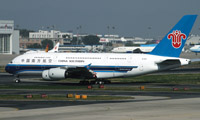Fleet
China leads the way in new plane market
Planes, planes and more planes. That’s the order not only for this year, but for the next two decades at Asia-Pacific airlines. Despite fragile economic conditions in the northern hemisphere, carriers in the region are showing no signs of losing enthusiasm for acquiring more and more seats.
April 1st 2013
When Airbus released its latest market forecast for the Asia-Pacific in late February the manufacturer’s chief operating officer, customers, John Leahy, had a familiar story to tell. In the next two decades carriers in the region will spend a staggering $1.6 trillion on some 9,870 new passenger and cargo aircraft. That’s 35% of the world total. Read More »
 |
| 'The Asia-Pacific market is where the action will be in the air transport market over the next 20 years' |
| John Leahy Chief Operating Officer, Customers Airbus |
In the passenger market, the fleet of aircraft operated by Asia-Pacific carriers is expected to more than double in the next 20 years, said Leahy. It will increase from 4,300 aircraft today to 10,440 jets, based on higher than average annual traffic growth of 5.8% and the replacement of nearly 3,500 aircraft in service today.
And both Airbus and rival manufacturer, Boeing, agree that China will remain the primary driver of fleet growth.
Indeed, Boeing expects its deliveries to China to grow by 60% this year, according to the president of Boeing China, Marc Allen.
Despite the Seattle manufacturer’s recent B787 woes he said Boeing plans to deliver more than 120 aircraft to China in 2013, including Dreamliners. He expected China’s economy and its civil aviation sector to grow faster this year than in 2012.
There may have been a slowdown in China’s economic growth, but it remains strong and the country’s thirst for domestic and international flying is robust. China’s foreign minister, Yang Jiechi, announced last month that Chinese made 83.18 million overseas trips in 2012 and the numbers continue to grow in excess of 6% a year.
China’s major airlines, China Southern, China Eastern and Air China, are cheering the hearts of planemakers, expanding their fleets as they grow their offshore networks. China Southern alone, the world’s third largest carrier with 491 planes, is taking delivery of 85 more planes this year
And while China may be the growth star in the Asian firmament it is by no means the only one. Mainline operators across the region continue to expand and modernize their fleets with purchases of larger aircraft. The number of single-aisle jets also will accelerate in coming years, largely driven by growth in the low-cost sector, according to Airbus’ Leahy.
 |
| 'The data tells us the market is strong and will continue to be strong. That’s why we’re confident as we raise our production rates' |
| Randy Tinseth Vice-President, Marketing Boeing |
“The Asia-Pacific market is where the action will be in the air transport market in the next 20 years,” he said. “Growing economies, bigger cities and increasing wealth will see more people flying, driving the need for larger and more efficient aircraft.”
Although much of the equipment focus has been on passenger aircraft there are signs the depressed freight market is gradually emerging from the gloom.
Last month, Cathay Pacific Airways announced an order for three B747-8 freighters, worth $1 billion, as well as options on five B777 freighters. The order will increase Cathay’s B747-8 freighter fleet to 13.
“The B747-8 freighter has provided our revamped cargo fleet with efficient fuel savings as well as added environmental benefits,” said Cathay chief executive, John Slosar.
There have been reports, as yet unconfirmed, that Australia’s Qantas Airways is looking to buy up to four B747-400 freighters. It currently does not own any large freighters, but wet leases three from Atlas Air. The lease on two of them expires early next year and the third in 2015.
Meanwhile, in 2012 Boeing regained the top spot as the world’s biggest commercial aircraft manufacturer for the first time in a decade. Boeing deliveries totalled 601 in 2012, the most since 1999. Airbus had a record year delivering 588 planes.
Boeing also claimed top spot in terms of net orders, winning 1,203 compared with 833 for Airbus. The European manufacturer still has a larger delivery backlog than Boeing, with a total order book of 4,682 aircraft. Boeing’s backlog stands at 4,400 planes.
Last month, Boeing’s vice-president marketing, Randy Tinseth, said that strong demand for its commercial aircraft and a healthy backlog are behind the company’s decision to keep increasing production rates.
“The data tells us the market is strong and will continue to be strong. That’s why we’re confident as we raise our production rates. Supply and demand will continue to be in balance as we put more aircraft into the hands of our customers,” he said at the International Society of Transport Aircraft Trading (ISTAT) Americas conference in Orlando.
 |
| China Southern Airlines: will take delivery of 85 new aircraft in 2013 |
He pointed out that passenger traffic was growing faster than capacity. “Utilisation rates and airline load factors are at historic levels and airlines continue to replace their older, less fuel-efficient aircraft,” said Tinseth.
“All of these factors play into our decision to ramp up production in a methodical, deliberate way. We constantly pulse the market to make sure we’re exactly where we need to be.”
Boeing is in the process of increasing its B737 production rate to 38 aircraft per month and will go to 42 in the first half of 2014.
The B777 programme recently ramped up production to a record 8.3 aircraft per month. The company aims to increase its B787 programme from five aircraft a month to 10 by the end of this year.
Tinseth said the economic life of aircraft continued to hold steady. “We’ve done exhaustive analysis of the data. Everything tells us that aircraft are long-lived assets and continue to be good investments,” he said.
There are, however, questions over Boeing’s performance this year as it strives to put the B787 back in the air. Still grounded, tests have so far failed to get to the bottom of the battery fire issue. Doubt remains about when the aircraft will return to commercial service.
This year appeared to start slowly for the region’s airlines, but January’s traffic figures were distorted because of the timing of the Chinese New Year holidays, which fell in the second week of February.
Year-on-year growth for Asia-Pacific airlines in the month was just 0.1%. However, after adjusting for the seasonal factors, the International Air Transport Association (IATA) estimated the actual growth would have been 3.5%.
This figure is still lower than the 2012 average of 5.3%. However, air travel expansion slowed sharply through the year and the results of the past few months represent an acceleration of demand.
After adjusting for seasonal factors, demand in the region was up 3% for Asia-Pacific airlines in January compared with a year ago. Load factors averaged 77.8%.
Association of Asia Pacific Airlines (AAPA) director general, Andrew Herdman, said a better sense of the underlying trends for passenger and cargo demand would be seen when February figures were available.
Looking ahead, he said that in line with the projected growth in the global economy, the outlook for passenger travel remained positive, underpinned by sustained growth in Asian markets and other developing economies.
“Hopefully, we could see some signs of recovery in the air cargo market this year, but even so cargo rates are likely to remain depressed due to considerable excess capacity in the industry,” said Herdman.
“Overall, airlines still face a very challenging operating environment and are focused on disciplined capacity management whilst responding to new market development opportunities.”